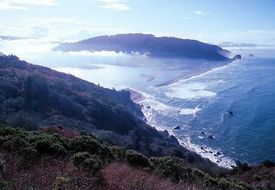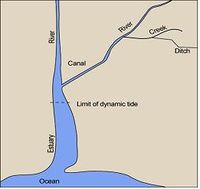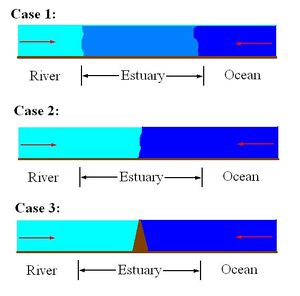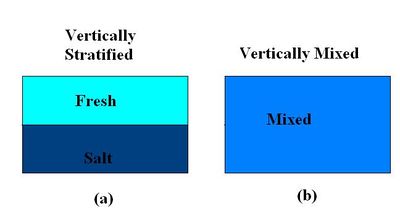Meeting of Fresh and Salt Water in the Qur'an
|
WikiIslam Archive,
Archives of the first iteration of WikiIslam, prior to acquisition and revamp by Ex-Muslims of North America
|
This article analyzes the apologetic claim that the Qur'an's statements regarding the meeting of fresh and salt water is miraculous or scientifically accurate.

Contents
- 1 Introduction
- 2 Analysis
- 2.1 River-ocean system
- 2.2 Making logical deduction based on the verse (without using science)
- 2.3 What the verse claims
- 2.4 What we expect elementary science to tell us
- 2.5 What modern science tells us about this process (Estuarine Physics)
- 2.6 How Islamic apologists explain this “scientific miracle”
- 3 Conclusion
- 4 See Also
- 5 References
Introduction
Apologists believe that Surah 25:53 of the Qur’an is scientifically accurate, interpreting it to mean that large bodies of salt and fresh water do not mix. They conclude that since the process was unknown to humankind during the time of Prophet Muhammad, this verse (and the Qur’an as a whole) is revealed by Allah.
Pickthal: And He it is Who hath given independence to the two seas (though they meet); one palatable, sweet, and the other saltish, bitter; and hath set a bar and a forbidding ban between them.
Shakir: And He it is Who has made two seas to flow freely, the one sweet that subdues thirst by its sweetness, and the other salt that burns by its saltness; and between the two He has made a barrier and inviolable obstruction.Another reference to "the two seas" (bahrayn) is found in the story of Moses and Khidir.
This may be compared to the ancient Akkadian myth of the Abzu, the name for a fresh water underground sea that was given a religious quality in Sumerian and Akkadian mythology. Lakes, springs, rivers, wells, and other sources of fresh water were thought to draw their water from the Abzu underground sea, while the Ocean that surrounded the world was a saltwater sea. This underground sea is called Tehom in the Hebrew Bible. For example, Genesis 49:25 says, "blessings of the heavens above, and Tehom lying beneath".[1] Wensinck explains, "Thus it appears that the idea of there being a sea of sweet water under our earth, the ancient Tehom, which is the source of springs and rivers, is common to the Western Semites".[2] Similarly in Greek mythology, the world was surrounded by Oceanus, the world-ocean of classical antiquity. Oceanus was personified as the god Titan, whose consort was the aquatic sea goddess Tethys. It was also thought that rainfall was due a third ocean above the "Firmament of the Sky" (a vast reservoir above the firmament of the sky is also described in the Genesis creation narrative).
Whether the two seas mentioned in the Qur'an referred to these mythological seas or a more general inviolable barrier between bodies of salt and fresh water, this article will demonstrate that the verse in question is scientifically wrong and that a layman could make a better guess than the author of the Qur'an.
Analysis
River-ocean system
When a river flows into the sea or ocean, there is a transition region in between. This transition region is what we call an estuary.[3] The river-estuary-ocean system is shown in Figure 1. The majority of readers will surely know about rivers flowing into the sea or ocean, and many would have already seen this in real life.

Making logical deduction based on the verse (without using science)
Let us completely ignore science for the time being. Rather, let us assume that we are scientifically illiterate. So we use our common sense only and make a series of logical deductions:
1. From the verse it is clear that during the time of Muhammad, people used to drink fresh water from river.
2. From the verses it is also clear that people knew that sea water is salty and unsuitable for drinking.
3. From the verses it is also clear that people knew that the river meets the ocean.
4. This means they knew that although the river meets the ocean, the ocean water is not coming into the river (otherwise the river water will taste salty).
5. So when the question “why is the ocean not coming into the river?” arose in their minds, what could have been their explanation?
A naive and vague explanation is that something is happening inside the meeting point of river and ocean (i.e. the estuary) which is not allowing the ocean to come into the river.
6. Now what is that “something”?
What is not allowing the ocean to come into the river?
Let us again have a look at Figure 1. Since an estuary is the place where this “something” is taking place, we can logically deduce three processes which are the most probable causes.
Case 1: A slow transition between river and ocean is taking place.
Case 2: A non-physical partition between the two water bodies is preventing them from coming into each other.
Case 3: A physical partition (like an underwater hill) is present and this separates the two water bodies.

layman (who has no knowledge of science but has common sense) can think of
All these cases are shown in Figure 2. So up to this point, we have not used anything other than common sense, but we have already made a lot of progress.
Surely people during the time of Muhammad had common sense. Even if they did not know how an estuary really works, they would have easily figured out that an estuary should behave very similar to all or some of these three cases.
What the verse claims
The verse states something very definite, that there is a “partition that is forbidden to be passed”. Only definite answers can be demanded for scientific claims. So let us again refer back to Figure 2 and decide which of the cases are closest to this verse. Surely it is either Case 2, Case 3 or both.
Why not Case 1? This is because Case 1 is a transition and not a forbidden partition. Since the only sources of water in an estuary are from the river and the ocean/sea, it automatically implies that the sea/ocean water mixes with the river water to produce this intermediate water. Still, if one argues that this intermediate water of Case 1 is the forbidden partition (and surely many apologists will make this argument), then we have the following answer:
It is evident from common sense that Case 2 is literally a forbidden partition. Now, Case 1 can only be true if Case 2 is false (i.e. when the interface in Case 2 is broken, only then Case 1 can arise). Hence, under any circumstances, Case 1 cannot be called a “forbidden partition”.
So according to this verse, Case 1 is discarded.
Summary of what the verse tells us
Let us summarize what the verse tells us. It tells us that:
A. the interface between sea water and river water acts as a forbidden partition, i.e. sea water cannot cross this partition and enter into the river (and vice versa). This is Case 2.
B. there is a physical partition like a landmass or something present in between the river and ocean and this prevents the mixing between the two water bodies. This is Case 3.
C. that forbidden partition is a universal truth. This means that the laws of nature will not allow any other circumstances (like Case 1).
What we expect elementary science to tell us
Firstly, let us ask ourselves what we expect from science. Science should corroborate observational evidences. So if we observe in our daily life that ocean water is not coming into the river (we drink river water regularly and its sweet taste remains unchanged), science should explain why this is happening. For example, if we observe that leaves are green, science should explain the reason why they are green. If it concludes that leaves are blue, then it is not science. So, let us scrutinize Cases 1, 2 and 3 under the light of elementary science.
What elementary science tells us
Let us assume that we have elementary knowledge of science. We will briefly recapitulate some of our elementary scientific knowledge.
- Elementary science tells us that if there is a porous membrane separating saline water from fresh water, then by the process of diffusion, the salt water will diffuse into the fresh water. If this system is kept for a long time, then the entire unit will become a mixture of fresh and salt water (brackish water).
- Elementary science also tells us about miscible and immiscible fluids. Water and oil are immiscible (i.e. they do not mix) whilst water and milk are miscible (they mix). It also tells us that salt water and fresh water are miscible fluids (water mixes with water).
- Elementary science also tells us that stirring helps in mixing. This is what we do when we add sugar or milk in a cup of coffee.
Now we consider the three cases and will conclude whether or not they are scientifically correct.
What about Case 1?
It seems correct. It does not contradict science.
What about Case 2?
It seems incorrect. It contradicts science. It assumes that river and ocean are like oil and water (i.e. they do not mix). A forbidden partition cannot exist between two miscible fluids. Even if we ignore the agents which are stirring up the water (like the flow of the river and ocean and the wind) and assume that the entire estuary is a stagnant mass, still by the process of diffusion, the fresh water will start mixing with salt water.
What about Case 3?
It seems correct. It does not contradict science. But inferring this does not need any knowledge of science at all. It comes from a minimal amount of common sense. Hence this claim is a trivial claim.
Now comes a question regarding the scientific justification of the verse. The verse claims that only Case 2 and/or Case 3 are universally correct. Elementary science has already disproved Case 2. Common sense tells us that it is an over-expectation if we assume that whenever there is a river meeting an ocean (i.e. within an estuary), there is always a physical barrier under the water.
So, what the verse claims is completely wrong and against elementary science (forget modern science). The only possible case (Case 3) which makes sense is a trivial case.
What modern science tells us about this process (Estuarine Physics)
Density of salt water is more than freshwater. This was first discovered by Aristotle. “The drinkable, sweet water, then, is light and is all of it drawn up: the salt water is heavy and remains behind.” -Aristotle (382 BC to 322 BC)
Thus, in estuaries, the dense salty water from the ocean should sink and fresh river water should rise to the top. If the denser liquid is at the bottom and the lighter liquid is at the top, this means that density is varying in vertical direction (See Figure 3.a). It is to be noted that Figure 3 (a) is an ideal condition, not a real condition. Even if we assume that the entire estuary is a stagnant mass of water, there will still be diffusion and fresh water will slowly start mixing with salt water. But as both of the water bodies are in motion, they will rapidly start to mix with each other. If a lot of circulation is present in the estuary (the agents which are responsible for this are tidal input, river output as well as the wind) then the entire estuary is vertically mixed. This is shown in Figure 3 (b)

Case (a) is an ideal condition, not a real condition
We have already introduced you to the basic physics of estuary. Now let us deal with a little advanced topic. Let us see how estuaries can be broadly classified based on circulation. On this basis, the different types of estuaries are:
- salt-wedge
- fjord
- partially mixed
- vertically homogeneous
- fresh water estuaries.
Fjords and freshwater estuaries will be discarded since they are not relevant to the discussion (you can read about them here and here).
Salt wedge
In this type of estuary, river output greatly exceeds marine input and tidal effects have a minor importance. Fresh water floats on top of the seawater in a layer that gradually thins as it moves seaward. The denser seawater moves landward along the bottom of the estuary, forming a wedge-shaped layer that is thinner as it approaches land. As a velocity difference develops between the two layers, shear forces generate internal waves at the interface, mixing the seawater upward with the freshwater. An example of a salt wedge estuary is the Mississippi River.
Partially mixed
As tidal forcing increases, river output becomes less than the marine input. Here, current induced turbulence causes mixing of the whole water column such that salinity varies more longitudinally rather than vertically, leading to a moderately stratified condition. Examples include the Chesapeake Bay and Narragansett Bay.
Vertically homogenous
Tidal mixing forces exceed river output, resulting in a well mixed water column and the disappearance of the vertical salinity gradient. The freshwater-seawater boundary is eliminated due to the intense turbulent mixing and eddy effects. The lower reaches of the Delaware Bay and the Raritan River in New Jersey are examples of vertically homogenous estuaries.[3][4]
National Oceanic and Atmospheric Administration (US Govt. Research Institute like NASA) have created some easy-to-understand graphics to explain the mixing in estuaries (take a look at them here).
So, in short, what does modern science tell us? It tells us that freshwater and salt water can have little (in salt wedge), medium (partially mixed) as well as complete (vertically homogeneous) mixing. There is no event where there will be zero mixing. Even in the absence of wind and currents (which is an absurd and non-physical condition), these two waters will start to mix by diffusion. So there is no “forbidden barrier” between freshwater and salt water. Hence this verse is contradictory to scientific facts.
How Islamic apologists explain this “scientific miracle”
Their claim is as follows:
Modern science has discovered that in estuaries, where fresh (sweet) and salt water meet, the situation is somewhat different from what is found in places where two seas meet. It has been discovered that what distinguishes fresh water from salt water in estuaries is a pycnocline zone with a marked density discontinuity separating the two layers. This partition (zone of separation) has a different salinity from the fresh water and from the salt water. (see Figure 4)

(zone of separation) between the fresh and the salt water. (Introductory Oceanography, Thurman, p. 301, with a slight enhancement.)
Analysis on this “scientific miracle”
Here we will show you how little apologists know about estuarine physics, and finally how they themselves have contradicted and proved the verse to be wrong.
Taking a look at Figure 4. you will notice the words “vertically mixed” in the figure. Hence they themselves have proven that river water has mixed with salt water. In fact, if you have understood the information provided in this article, you will also understand that they have chosen the worst possible case (Vertically Homogeneous Estuary). This estuary is the opposite to what the Qur’an states. So if they were a little smarter, they would have chosen Salt Wedge estuary. In that case we would have to write an additional paragraph to refute their claims.
Again look at Figure 4 and note the caption underneath that reads, “with slight enhancement”. The words “Zone of Separation” and “The partition” have been added on to Figure 4 by the apologists, the book does not claim such a thing.
How the “scientific miracle” apologists make false statements and distort information
The apologists state, “..what distinguishes fresh water from salt water in estuaries is a pycnocline zone with a marked density discontinuity separating the two layers”. Pycnocline is produced by a vertical density gradient in a body of water.[6] When the water is all mixed, there is no vertical density gradient (see the section on “Vertically Homogeneous”). This means there is no pycnocline zone. So, they are talking about a pycnocline zone (and if they understood the physics correctly, then they should be showing a picture like Figure 3.a) but they are showing a picture which has no pycnocline, i.e. Figure 4.
A pycnocline zone, and more specifically, a halocline zone, is always a mixture of fresh water and salt water. It is a product of their mixing. In case of salt water and fresh water, there cannot be density discontinuity. The later can only be present if two liquids are immiscible, for example water and oil.
The apologists also state, “This partition (zone of separation) has a different salinity from the fresh water and from the salt water. (see Figure 4) This information has been discovered only recently, using advanced equipment to measure temperature, salinity, density, oxygen dissolubility, etc.” So they claim that this physics has only been recently understood, in order to emphasizes that someone 1400 years ago (i.e. the author of the Qur'an) knew about it.
But, firstly, the verse does not describe anything related to Figure 4, rather the opposite, and we have proved it conclusively. Secondly, let us go back to Figure 2 and look at Case 1. Also read the caption. Case 1 of Figure 2 was what a layman (a person with common sense and no knowledge of science) can draw. Is there any difference between Figure 4 and the Case 1 of Figure 2? Almost nothing. They represent almost the same physics. This shows that science is just refinement of common sense. What science has done is that it has understood the physics more deeply and found out the different amounts of salinity (given in parts per thousand ‰) as shown in Figure 4.
Conclusion
Hence, we can conclude that:
- the verse is undoubtedly a scientific error
- a layman can get very close to the actual physics without any divine knowledge
- “scientific miracle” apologists make false statements and distort information to show that this scientific error is a scientific miracle
See Also
- I. A. Ibrahim - A hub page that leads to other articles related to I. A. Ibrahim
- Contradictions and Errors - A hub page that leads to other articles related to contradictions and errors
References
- ↑ Wensinck, Arent Jan (1918). "The Ocean in the Literature of the Western Semites". Verhandelingen der Koninklijke Akademie van Wetenschappen te Amsterdam. Afdeeling Letterkunde. Nieuwe reeks. dl. 19. no. 2. page 14
- ↑ ibid. page 17
- ↑ 3.0 3.1 Estuary - Wikipedia, accessed August 15, 2012
- ↑ Kennish, M.J. (1986) “Ecology of Estuaries. Volume I: Physical and Chemical Aspects.” Boca Raton, FL: CRC Press, Inc. ISBN 0849358922
- ↑ From A Brief Illustrated Guide to Understanding Islam found at islam-guide.com. There are literally hundreds of Islamic websites with the same claims.
- ↑ Pycnocline - Wikipedia, accessed August 16, 2012